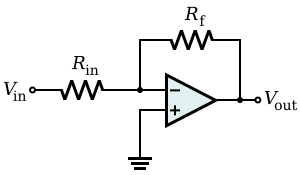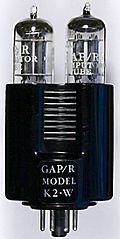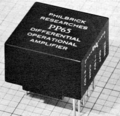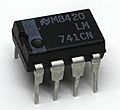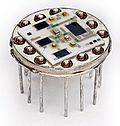Operational amplifier facts for kids

The μA741, a popular early integrated op amp
|
|
| Type | Discrete circuit Integrated circuit |
|---|---|
| Invented | Karl D. Swartzel Jr. |
| Pin configuration |
|
| Electronic symbol | |
 Circuit diagram symbol for a representative op amp. Pins are labeled as listed above. |
|
An operational amplifier (often called an op amp) is a special electronic device that makes a small electrical signal much, much bigger. Think of it like a super-powered magnifying glass for electricity! It has two inputs and one output. The op amp looks at the tiny difference between its two inputs and then makes the output voltage huge, usually 100,000 times larger.
Op amps were first used in old-fashioned analog computers. These computers used electricity to do math problems. Op amps helped them perform calculations like adding, subtracting, and more.
People love op amps because they are very flexible. You can add other parts to an op amp circuit to control how much it amplifies, how it handles different frequencies, and how it reacts to changes in temperature. This means they can be used for many different jobs in electronics.
Today, op amps are found in almost every electronic device, from your phone to scientific instruments. Many basic op amps are very cheap, costing only a few cents. But some special ones can be quite expensive. They can be single components or part of bigger integrated circuits (ICs).
Op amps are a type of "differential amplifier." This means they amplify the difference between two signals. Other types of differential amplifiers exist, but the op amp is one of the most common.
Contents
How Op Amps Work
An op amp has two main inputs:
- The non-inverting input (marked with a +)
- The inverting input (marked with a −)
It only cares about the difference in voltage between these two inputs. Let's call this difference the differential input voltage. The op amp then makes the output voltage, Vout, much larger based on this difference.
The basic idea is: Vout = AOL × (V+ − V−)
Here, AOL is the "open-loop gain." This is how much the op amp amplifies the signal without any special connections back to the input.
Open-Loop: Like a Simple Switch
The AOL (open-loop gain) is usually huge, like 100,000 or more! This means even a tiny difference between the + and − inputs will make the output go to its highest or lowest possible voltage. It's like a super sensitive switch.
Because this gain is so big and hard to control precisely during manufacturing, you usually don't use an op amp like this by itself to amplify signals.
Without any feedback, an op amp acts like a voltage comparator. It simply compares the two input voltages. If the voltage at the + input is higher than the − input, the output goes to its maximum positive voltage. If the voltage at the − input is higher, the output goes to its maximum negative voltage.
Closed-Loop: Making it Useful with Feedback
To make an op amp useful and predictable, we use something called negative feedback. This means we take a small part of the output voltage and send it back to the inverting (−) input.
This feedback might seem strange, but it actually makes the op amp's huge gain much smaller and much more controlled. With negative feedback, the overall gain of the circuit is mostly decided by the other components you connect, not by the op amp itself. This makes op amp circuits very stable and reliable.
Here are two simple "golden rules" for how op amps work with negative feedback:
- The op amp tries to make the voltage difference between its two inputs zero.
- The inputs of the op amp don't draw any current.
These rules help engineers design and understand op amp circuits.
Let's look at an example: a non-inverting amplifier. This circuit makes the output voltage change in the same direction as the input. If the input goes up, the output goes up.
In the picture, the resistors Rf and Rg create the negative feedback. They take a part of the output voltage and feed it back to the inverting input. Because of the feedback, the op amp will adjust its output until the voltage at the inverting input is almost exactly the same as the input voltage (Vin).
The voltage gain of this circuit is simply: Gain = 1 + (Rf / Rg)
So, if Rf and Rg are equal, the gain is 1 + 1 = 2. This means if you put in 1 volt, you get 2 volts out!
Op Amp Features
Ideal Op Amps: The Perfect Dream
Imagine a perfect op amp. It would have these amazing features:
- Infinite gain: It could amplify a signal endlessly.
- Infinite input resistance: No current would ever flow into its inputs.
- Zero output resistance: It could provide any amount of current without its output voltage dropping.
- Infinite bandwidth: It could amplify signals of any frequency.
- No noise: It would never add any unwanted static or hum.
Of course, no real op amp is perfect, but engineers design them to get as close as possible to these ideal features.
Real Op Amps: What They're Really Like
Real op amps are amazing, but they have some limits compared to the ideal ones:
- Limited Gain: Their open-loop gain is very high (like 100,000), but not infinite.
- Non-Zero Output Resistance: They have a small amount of resistance at their output.
- Limited Input Resistance: A tiny bit of current can flow into their inputs.
- Input Offset Voltage: Sometimes, even if both inputs are connected to the same voltage, the output might not be exactly zero. This is like a tiny built-in error.
- Limited Bandwidth: They can only amplify signals up to a certain frequency. At higher frequencies, their gain starts to drop. This can cause problems like making the circuit unstable or distorting the signal.
- Noise: Like all electronic devices, op amps create a small amount of unwanted electrical noise.
- Saturation: The output voltage can't go higher than the positive power supply or lower than the negative power supply. It "saturates" or "clips" at these limits.
- Slew Rate Limiting: The output voltage can only change so fast. If you try to make it change faster than its "slew rate," the output will look distorted. For example, a common 741 op amp can only change its output by about 0.5 volts per microsecond.
- Limited Output Current: Op amps can only provide a certain amount of current. If you try to draw too much, they might limit the current to protect themselves.
Modern op amps, especially those made with MOSFETs, are much closer to the ideal in terms of input resistance.
Inside a 741 Op Amp
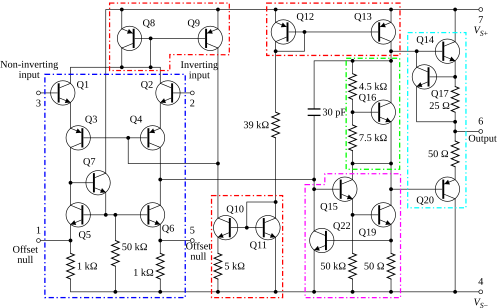
The 741 op amp is a very famous and common type, first made in 1968. It's a great example to see how op amps are built inside. It has three main parts, or "stages," that work together:
- Differential Amplifier (blue): This is the input stage. It takes the two input signals and finds the difference between them. It also helps the op amp have high input resistance and low noise.
- Voltage Amplifier (magenta): This stage takes the small difference signal from the first stage and makes it much larger.
- Output Amplifier (cyan and green): This is the final stage. It makes sure the op amp can deliver enough current to whatever it's connected to. It also protects the op amp from damage if too much current is drawn.
The 741 also has special circuits called "current mirrors" (red) that help set up the correct currents inside the chip. It also has a small capacitor (30 pF) that helps keep the amplifier stable and prevents it from oscillating (like making unwanted squealing sounds).
Types of Op Amps
Op amps can be made in different ways:
- Discrete: Built from many separate transistors and other parts.
- Hybrid: A mix of separate parts and small integrated circuits.
- Integrated Circuits (ICs): Most common today. These are built on a single tiny chip of silicon.
IC op amps can also be sorted by:
- Quality: Some are made for tough conditions (military, industrial), others for everyday use (commercial).
- Package Type: How they are physically packaged, like DIP (which you can plug into a board) or smaller surface-mount types.
- Internal Compensation: Some have built-in parts to prevent instability, making them easier to use.
- Number of Op Amps: You can find single, dual (two), or quad (four) op amps in one package.
- Rail-to-Rail: These can handle input and output signals that are very close to the power supply voltages, which is useful in low-voltage circuits.
- CMOS Op Amps: These have extremely high input resistance, meaning almost no current flows into their inputs.
What Op Amps Are Used For
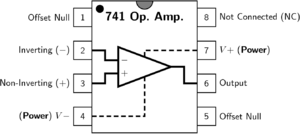
Op amps are like versatile building blocks for electronic circuits. Instead of designing a circuit with hundreds of tiny transistors, engineers can just use an op amp as a single, powerful component.
Using Op Amps Without Feedback (Comparators)
As we learned, without feedback, an op amp acts like a voltage comparator. It's like a very sensitive switch.
- Voltage Level Detector: You can set a "reference" voltage. If the input voltage goes above that reference, the output switches on. If it goes below, the output switches off.
- Zero Voltage Level Detector: This is a special type of level detector that switches when the input voltage crosses zero. It can turn a smooth wave (like a sine wave) into a square wave. This is useful for timing or creating digital signals.
Using Op Amps with Positive Feedback
Sometimes, a small amount of positive feedback is used. This means a part of the output signal is sent back to the non-inverting (+) input. One important use for this is in a Schmitt trigger circuit, which is like a comparator with a "memory" that prevents it from flickering when the input signal is noisy.
Using Op Amps with Negative Feedback
This is the most common way to use op amps because it makes them stable and predictable.
Non-Inverting Amplifier
In this setup, the output voltage moves in the same direction as the input voltage. If you put in a positive voltage, you get a positive voltage out. The gain (how much it amplifies) is controlled by two resistors. We already saw the formula: Gain = 1 + (R2 / R1)
Inverting Amplifier
In an inverting amplifier, the output voltage moves in the opposite direction to the input voltage. If you put in a positive voltage, you get a negative voltage out. The gain is also controlled by two resistors: Gain = − (Rf / Rin) The minus sign means the output is inverted.
Other Cool Uses
Op amps are used in tons of other circuits, like:
- Audio and Video Amplifiers: Making signals louder or stronger.
- Filters: Removing unwanted frequencies from a signal (like getting rid of hum).
- Rectifiers: Turning AC signals into DC signals very precisely.
- Voltage Regulators: Keeping voltage levels steady.
- Analog Calculators: Performing math operations like adding, subtracting, or even more complex ones.
- Oscillators: Creating repeating electronic signals (like sine waves or square waves).
Many op amps have a standard way their pins are arranged, so you can often swap one type for another without changing the wiring. Engineers choose specific op amps based on what they need for a circuit, like how much gain, how wide the frequency range, how much noise, or how much power it uses.
Op Amp History Timeline
Op amps have a long and interesting history, starting even before modern computers!
- 1941: The First Op Amp (Vacuum Tube)
Karl D. Swartzel Jr. from Bell Labs created the first device that worked like an op amp. It used three vacuum tubes and could amplify signals by 90 times. This early op amp was super important during World War II in a special artillery aiming system, helping to hit targets with amazing accuracy.
- 1947: Op Amp with Two Inputs
John R. Ragazzini formally named and described the "operational amplifier." A student named Loebe Julie designed an op amp with a big improvement: it had two inputs (one inverting, one non-inverting). This opened up many new possibilities for how op amps could be used.
- 1949: The Chopper-Stabilized Op Amp
Edwin A. Goldberg invented a "chopper-stabilized" op amp. This design made op amps much more stable and accurate, even though it meant you couldn't easily use the non-inverting input for other things.
- 1953: First Commercial Op Amp
The first op amps you could buy were made by George A. Philbrick Researches. They were still made with vacuum tubes and were quite large.
- 1961: Solid-State Op Amps
With the invention of the transistor, op amps started to become smaller and more reliable. The first "solid-state" op amps were like tiny circuit boards.
- 1962: Op Amps in Modules
Companies started putting op amps into small, sealed boxes called "modules." You could just plug these modules into a circuit board, making it much easier to use op amps as ready-made components.
- 1963: First IC Op Amp
Bob Widlar at Fairchild Semiconductor created the first "monolithic" IC op amp, the μA702. "Monolithic" means it was all on a single tiny chip. This was a huge step towards the small, cheap op amps we have today.
- 1968: The Famous μA741 is Released
The μA741, designed by David Fullagar, became incredibly popular. It was similar to earlier designs but had a special capacitor built right into the chip. This made it much easier to use, and it quickly became the standard op amp. Even today, many op amps are based on the 741's design.
- 1970s and Beyond: Faster, Smaller, Better
In the 1970s, op amps became even faster and more efficient, using new types of transistors like FETs and MOSFETs. Companies also started making op amps that could work with just one power supply (instead of two) and put multiple op amps into a single package.
- Recent Trends: Low Voltage and Rail-to-Rail
Today, electronic devices often use very low voltages. So, modern op amps are designed to work with these low voltages (like 5V or even 1.8V). Many also have "rail-to-rail" outputs, meaning their output signal can go almost all the way from the lowest power supply voltage to the highest.
|
- Active filter
- Analog computer
- Bob Widlar
- Current conveyor
- Current-feedback operational amplifier
- Differential amplifier
- George A. Philbrick
- Instrumentation amplifier
- Negative feedback amplifier
- Op-amp swapping
- Operational amplifier applications
- Operational transconductance amplifier
- Sallen–Key topology
See also
 In Spanish: Amplificador operacional para niños
In Spanish: Amplificador operacional para niños






